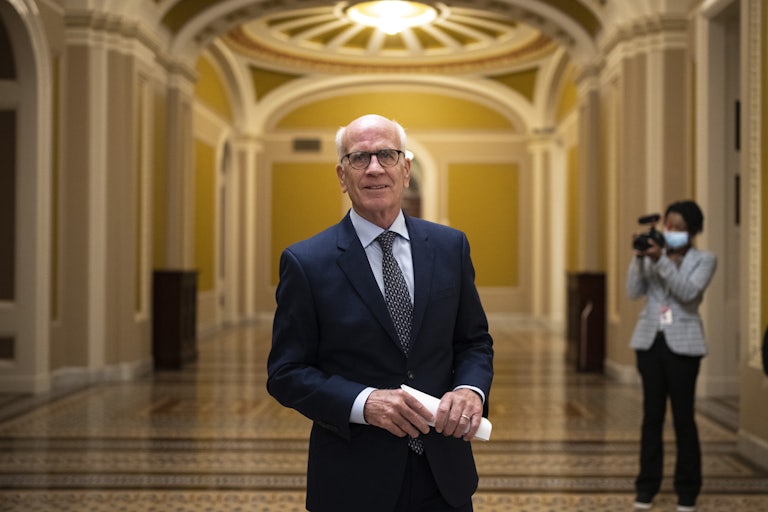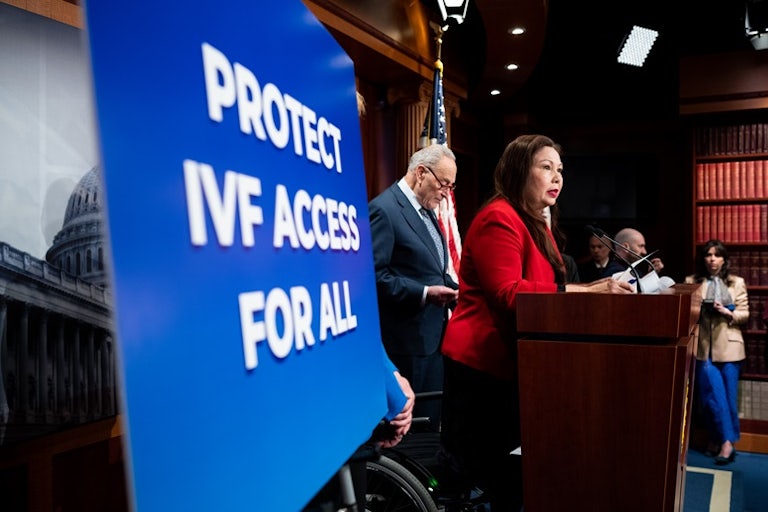The Tragic Fallout of the World Central Kitchen Airstrikes
The IDF’s attack on food aid workers in Gaza is roiling Washington—and having a chilling effect on everyone working to stave off starvation.

This week, after Israeli airstrikes killed seven workers from World Central Kitchen—the globe-trotting food aid organization famous for showing up wherever there are people in need (including Washington, during government shutdowns)—multiple humanitarian organizations have suspended their operations in Gaza due to concerns about the safety of their staff. These workers were killed despite traveling through a “deconflicted zone” in armored cars clearly labeled with the World Central Kitchen logo and sharing their movements with the Israeli military. World Central Kitchen, a humanitarian organization founded by celebrity chef José Andrés, is among the groups pausing their operations in Gaza, even as more than one million Palestinians are on the brink of starvation.
Andrés told Reuters in an interview that the convoy had been targeted “systematically, car by car.” “This was not just a bad luck situation where ‘oops,’ we dropped the bomb in the wrong place,” Andrés said. The strikes hit the convoy shortly after it left its warehouse in Deir Al Balah, where it unloaded over 100 tons of food aid.
Jeremy Konyndyk, the president of Refugees International and a former top official at USAID, called the strike on the World Central Kitchen convoy a “significant escalation,” notable in part because the organization had worked to coordinate their efforts with the Israeli military. But he also noted that many Palestinian aid workers have been killed since the onset of the war in October; the United Nations has reported that more than 180 humanitarian workers have died.
“Israel is trying really hard to portray this as a one-off, an accident and aberration, and it’s none of those things. The only thing that is different here is that it was international personnel,” Konyndyk said. “This one is different in degree—it is even more egregious, it is more severe, it is grotesque. But it is grotesque in a way that follows a pattern of [Israel Defense Forces] behavior.”
Anera, an organization that provides aid in the Middle East, which has partnered with World Central Kitchen and other groups, is also temporarily suspending its operations. The deaths of the humanitarian workers this week come after the killing of Anera worker Mousa Shawwa last month. As with the seven workers killed this week, Shawwa had shared his coordinates and movements with the Israeli military before his death. Sandra Rasheed, the Palestine director for Anera, said in an interview that aid workers in Gaza had been concerned about their safety after the death of Shawwa and his young son shortly thereafter.
“When April 1 happened, and the WCK convoy was deliberately and intentionally targeted and attacked, and there were seven people that were killed that day, that was a real big shocker to them. They were really worried, [and] they knew that it could have been them,” Rasheed said about the Anera workers, who coordinated closely with World Central Kitchen on the ground. Although Israeli Prime Minister Benjamin Netanyahu confirmed that strikes occurred, he called them “unintentional,” and other Israeli military leaders have characterized them as an error—but this does not reassure Anera workers, Rasheed said.
The deaths of the World Central Kitchen workers have invited international condemnation, including some of the strongest criticism from President Joe Biden. (The Biden administration has continued to approve munitions and aid for Israel, although Congress has not approved new military assistance since the Hamas attack on Israel on October 7.) In Washington, Andrés is an institution, respected across the political class; the deaths of the World Central Kitchen staff may thus resonate with American politicians more than the everyday devastation of Israeli strikes in Gaza. Rasheed theorized that the international community had become accustomed to the deaths of Palestinians, which have topped 30,000, according to health officials in Gaza.
“When the world sees images of international aid workers who are going into a crisis situation, who are going there to serve and to support the people, and then they are killed, that is a shock for them,” Rasheed said.
The pause in operations is temporary, Rasheed said, noting that Anera is still working on aid procurement. However, she said that she would like to see accountability for the Israeli military and more pressure put on the U.S. to stop supplying weapons to Israel.
“Are we being naïve that that would happen? I’m not so sure. I think that the shock of what happened and even some of the initial language of what President Biden said, shows an indication that people are starting to think that people need to be held accountable, that this needs to stop,” Rasheed said.
In a statement on Tuesday, Biden said that he was “outraged” by the incident. However, Politico reported that, while privately “angry,” Biden did not plan on changing the country’s policy toward Israel anytime soon.
“It’s very hard for me to see any real prospect of Israeli behavior changing without the U.S. government majorly upping the ante. Netanyahu has shown repeatedly that he will happily ignore the guidance that he gets,” argued Konyndyk. “As long as the approach of the U.S. government is to urge him to change, rather than deploy leverage to force him to change policy, he won’t change.”
This article first appeared in Inside Washington, a weekly TNR newsletter authored by staff writer Grace Segers. Sign up here.


















